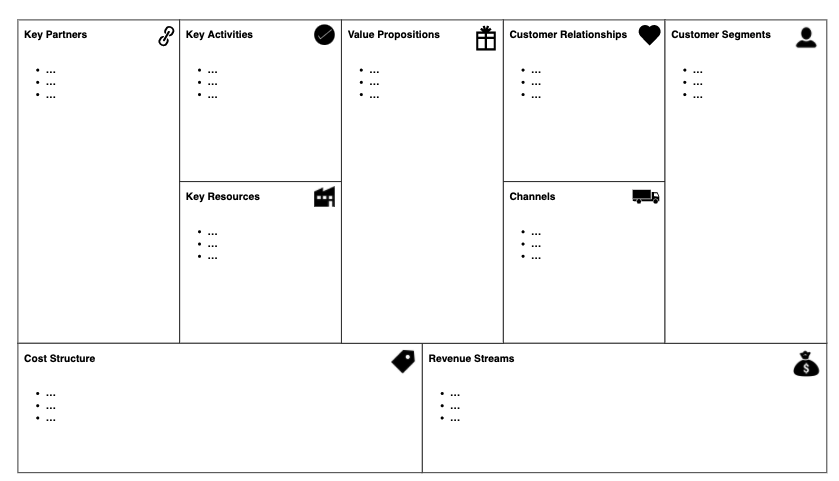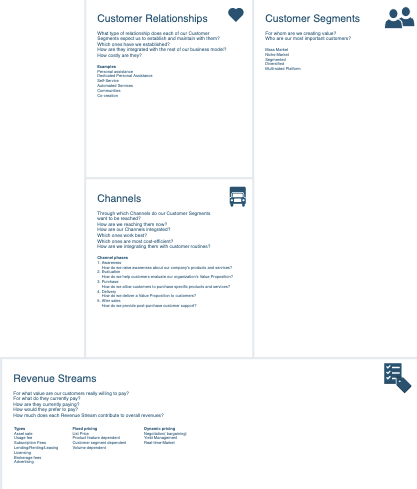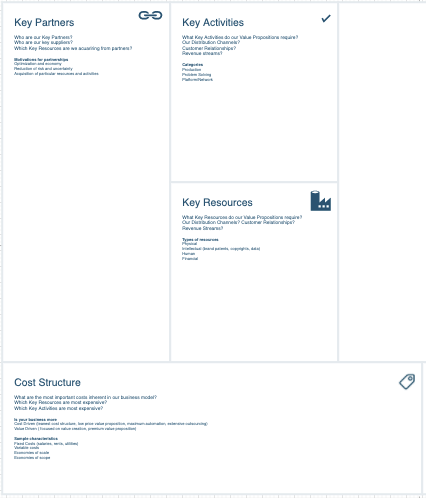When launching a new business or product or service – or even when just keeping what you’ve already got thriving and growing into the future – it’s important to know all the facts. Get your house in order. Keep your ducks in a row. And one of the best ways to keep those ducks marching together is to create and maintain a simple but infinitely useful tool called the Business Model Canvas.
Let’s talk about the Business Model Canvas. What is it? What can it do for you? How does it work? And how can draw.io in Confluence help you and your team collaborate to get it just right?
What is the Business Model Canvas?
The Business Model Canvas (BMC) is a strategic management tool that makes it easier to quickly define and communicate a business idea or concept. It’s a one-page document, arranged in a grid, that lists the fundamental elements of a product or business, structuring an otherwise complex or poorly defined idea in a coherent way.

The right side of the BMC focuses on external factors dealing with customers and the resulting revenue streams. The left side of the canvas focuses on internal business factors and the associated costs. Occupying the center of the grid and tying everything together is the Value Proposition, which defines the exchange of value between your business/product and your customer/clients.
It all adds up to nine factors that combine to give you increased clarity about the overall direction of your business and your relationship with your public. Let’s explore the Right, Left, and Center (but without all those annoying political implications).
The center
The anchor of the Business Model Canvas is the center box. This is where you paint a portrait of the Value Proposition that you or your product provide for your customers (more on them in a moment). Your value proposition is the totality of the problems or needs that you’re fulfilling. The pains you’re alleviating. What’s unique about your value proposition as opposed to your competition? Rank them and choose the most crucial factors that influence customers to walk through your (actual or virtual) door.

The right
Customer Segments
Customer Segmenting means dividing your customer base into groups of customers who are similar in a variety of ways ranging from age to gender to interests and spending habits. Ask yourself some specific questions when identifying your Customer Segments:
- Whose problem are we solving?
- Who wants what we have to offer (our value proposition)?
- Are they individuals or other businesses?
- Are they predominately male, female, or both?
- What age groups step to the front of the line?
And while you’re at it, create customer personas to represent each of your Customer Segments.
Customer Relationships
What is the relationship you have with your customers?
The Customer Relationships box is for identifying all the ways in which you interact with your customers. Do you meet with them in person, over the phone, through third-party contractors, events (one-to-many), something else?
Channels
Channels are the ways in which your customer comes into contact with you. It’s how you reach them and make them a part of your sales cycle. It’s how you tell them about your value proposition?
Where are your customers? How do they communicate or consume media?
Some possible channels include:
- Social media
- Public speaking
- Email marketing
- Networking
- Viral marketing
- Targeting blogs
- Social advertising
- Trade shows
- Content marketing
- Community building
- Offline advertising (billboards, TV, radio)

Knowing who they are and what they want is worthless if you can’t talk to them. It’s like all those online daters who won’t pay the extra fee for messaging.
Don’t be like them.
Revenue Streams
You know about Revenue Streams. They’re the ways in which your business converts that Value Proposition into financial gain. This is the magical box in which you uncover how that revenue makes its way into your pocket. Is it pay per product (pay per view)? Fee for service? Fixed-rate? Subscription? Something else?
The left

To the left of those value propositions, we find the business side of the operation.
Key Activities
The Key Activities are the things your business does to provide the value proposition for your customers. What activities does that proposition require? What resources are used? Think about distribution, strategy, technical development, as well as simply the acts that you or your business perform in order to create that value for your customers. Things like designing, consulting, manufacturing, publication, baking, painting, building, and more and more.
Key Resources
What resources do you require to do business? What are the specific items, services, staff, etc that make it possible to complete the Key Activities listed above? Office space. Web hosting. Vehicles. Electricity. You get the point.
Key Partners
Which brings us to Key Partners, or all of the external companies/parties/suppliers you need to achieve your Key Activities and deliver value to the customer. If you’re not able to achieve the value proposition alone, who else do you need to rely on to do it? These are the key partners that allow you to deliver whatever it is your customer needs.
Cost Structures
…and you can’t have all those beautiful revenues without their ugly twin, costs. How much do all of these things cost? What are the costs of those key resources and partnerships? Legal costs?
Legal? Payrolls? Insurance?
Connections
Now take some time to connect the dots. Map connections from Propositions to Segments to Revenue Streams or Propositions to activities, resources, and costs. Each box does not stand alone. Stand back and discover the many ways in which all of these factors interact and influence each other. These connections may be simple or they may be incredibly complex. Either way, they provide insight into the nervous system of your business and how to keep it firing on all cylinders.
Putting it together
But you’ve got a diverse team, and all of them are going to have input, and all of them have schedules that could make Google Calendar cry and look for a different line of work. How do you bring these people together in one place to work on this vital business document?
You don’t.
Working through Confluence, draw.io gives you all the tools you need to create your Business Model Canvas and collaborate with your entire team to populate it. Everyone working in the same document.
Want to know how it all works? Check out this video link on creating templates from existing diagrams in draw.io for Confluence. Or read all about it on our blog.
Last Updated on December 2, 2021 by Admin

